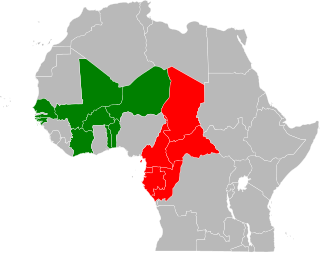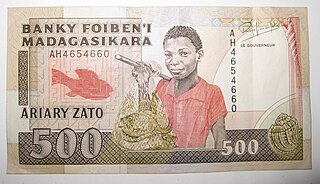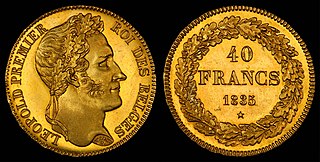
The CFA franc is the name of two currencies, the West African CFA franc, used in eight West African countries, and the Central African CFA franc, used in six Central African countries. Although separate, the two CFA franc currencies have always been at parity and are effectively interchangeable. The ISO currency codes are XAF for the Central African CFA franc and XOF for the West African CFA franc. On 22 December 2019, it was announced that the West African currency would be reformed and replaced by an independent currency to be called Eco.

The CFP franc is the currency used in the French overseas collectivities of French Polynesia, New Caledonia, and Wallis and Futuna. The initials CFP originally stood for colonies françaises du Pacifique but since 2022 is officially Collectivités françaises du Pacifique. Its ISO 4217 currency code is XPF. The CFP franc is subdivided into 100 centimes, although there are no centime denominations. The currency is issued by Institut d'émission d'outre-mer (IEOM).
The ouguiya, at one time spelled "ougiya", is the currency of Mauritania. Each ouguiya constitutes five khoums. As such it is one of two circulating currencies, along with the Malagasy ariary, whose division units are not based on a power of ten.
The Congolese franc is the currency of the Democratic Republic of the Congo. It is subdivided into 100 centimes. However, centimes no longer have a practical value and are no longer used. In April 2022, 2,000 francs was equivalent to US$1.

The ariary is the currency of Madagascar. It is notionally subdivided into 5 iraimbilanja and is one of only two non-decimal currencies currently circulating. The names ariary and iraimbilanja derive from the pre-colonial currency, with ariary being the name for a silver dollar. Iraimbilanja means literally "one iron weight" and was the name of an old coin worth 1⁄5 of an ariary. However, as of May 2023, the unit is effectively obsolete since the iraimbilanja has practically no purchasing power, and the coins have fallen into disuse.

The kip is the currency of Laos since 1955. Historically, one kip was divided into 100 att (ອັດ).

The Belgian franc was the currency of the Kingdom of Belgium from 1832 until 2002 when the Euro was introduced. It was subdivided into 100 subunits, each known as a centiem in Dutch, centime in French or a Centime in German.

The Luxembourg franc (F or ISO LUF, Luxembourgish: Frang), subdivided into 100 centimes, was the currency of Luxembourg between 1854 and 2002, except from 1941 to 1944. From 1944 to 2002, its value was equal to that of the Belgian franc. The franc remained in circulation until 2002, when it was replaced by the euro.
The franc is the currency of Burundi. It is nominally subdivided into 100 centimes, although coins have never been issued in centimes since Burundi began issuing its own currency. Only during the period when Burundi used the Belgian Congo franc were centime coins issued.
The franc is the official currency of Comoros. It is nominally subdivided into 100 centimes, although no centime denominations have ever been issued.
The franc was the currency of the Anglo-French Condominium of the Pacific island group of the New Hebrides. It circulated alongside British and later Australian currency. The New Hebrides franc was nominally divided into 100 Centimes, although the smallest denomination was the 1 franc. Between 1945 and 1969, it was part of the CFP franc.
The Malian franc was the independent currency of Mali between 1962 and 1984. Although technically subdivided into 100 centimes, no subdivisions were issued.

The Central African CFA franc is the currency of six independent states in Central Africa: Cameroon, Central African Republic, Chad, Republic of the Congo, Equatorial Guinea and Gabon. These six countries have a combined population of 55.2 million people, and a combined GDP of over US$100 billion.

The West African CFA franc is the currency used by eight independent states in West Africa which make up the West African Economic and Monetary Union : Benin, Burkina Faso, Côte d'Ivoire, Guinea-Bissau, Mali, Niger, Senegal and Togo. These eight countries had a combined population of 105.7 million people in 2014, and a combined GDP of US$128.6 billion.

The franc was the currency of Tunisia between 1891 and 1958. It was divided into 100 centimes (صنتيم) and was equivalent to the French franc.
The Central Bank of Madagascar is the central bank of Madagascar.
The franc was the currency of Réunion until 1999. Before 1975, Réunion had its own franc, distinct from that of France. After 1975, the French franc circulated. Réunion now uses the euro. The Réunion franc was subdivided into 100 centimes.
The franc is the currency of New Caledonia and Wallis and Futuna, part of the CFP franc since 1945 and issued by the Institut d'émission d'outre-mer (IEOM) in Paris. It is subdivided into 100 centimes, although centime denominations are no longer in circulation.
The franc is the currency of French Polynesia, part of the CFP franc since 1945 and issued by the Institut d'émission d'outre-mer (IEOM) in Paris. It is subdivided into 100 centimes, although centime denominations are no longer in circulation.

The Banque de Madagascar, from 1946 the Banque de Madagascar et des Comores, was a bank established by the French government in 1925 to issue currency and provide credit in French Madagascar. As such, it fulfilled many of the functions of a central bank for the colony.













